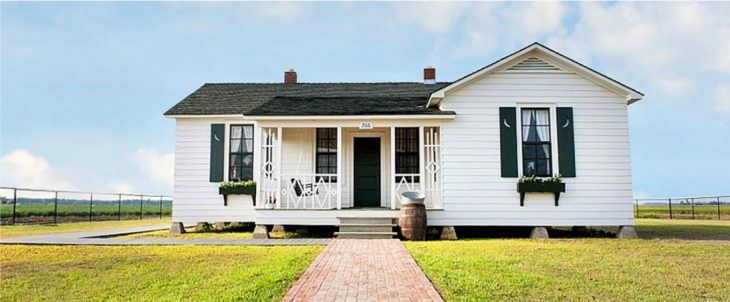ASU Heritage Sites awarded two grants for Dyess Colony, Hemingway-Pfeiffer museum
by June 3, 2019 3:49 pm 670 views

The restored Cash home in the Dyess Colony.
Arkansas State University’s Heritage Sites has been awarded two grants totaling $638,050 from the Arkansas Natural and Cultural Resources Council (ANCRC) for preservation projects in the Dyess Colony Circle, part of the Dyess Colony: Johnny Cash Boyhood Home, and at the Hemingway-Pfeiffer Museum and Educational Center (HPMEC) in Piggott.
The first grant is $512,050 to renovate the remaining historic property owned by ASU in the Dyess Colony Circle for use as the Dyess Colony Rural Life Research Center.
The second is for $126,000 to document the last remaining historic Pfeiffer farmstead (house, hay barn, mule barn, corn crib, chicken house and smoke house) through Historic American Buildings Survey drawings (HABS) and large format photographs in conjunction with the National Park Service for permanent archiving in the Library of Congress.
“Through our ANCRC grants, we have been able to identify, research and restore heritage sites and historic material culture in the Arkansas Delta that have regional, state, national and even international significance,” Dr. Ruth Hawkins, executive director of Arkansas State University Heritage Sites, said. “We are grateful to the Arkansas Natural and Cultural Resources Council, along with other partners who have assisted in funding the projects to date.”
During the past five years, heritage sites that have been aided by ANCRC grants include the Historic Dyess Colony Administration Building restoration, the former Dyess Colony Theatre adaptive reuse and the 1936 V. C. Kays house, home of the university’s first president, Hawkins said. Currently, restoration of the Lakeport Plantation dairy building in Lake Village is underway.
“These ANCRC projects also have included the Hemingway-Pfeiffer house and barn in Piggott, the Lakeport Plantation and the Southern Tenant Farmers Union headquarters in Tyronza. The projects have had a twofold impact in terms of serving as educational resources and enrichment experiences, as well as serving as economic catalysts for the rural regions in which they are located, she said.”
The Dyess Colony Rural Life Research Center will house research materials, including original colony documents, photographs, farm objects and Dyess colony papers from the National Archives and the Library of Congress.
Furthermore, Johnny Cash’s daughters have donated archival materials and photographs related to his childhood in Dyess, such as report cards, Boy Scout records, drawings and poems, school programs, elementary and secondary permanent records, and other items.
“This project is part of the overall master plan to develop Dyess as a heritage tourism destination through a partnership between Arkansas State University and the town of Dyess,” continued Hawkins. “Utilizing preservation-based economic development strategies has the potential to generate $10 million annually for the Northeast Arkansas economy, as well as create approximately 100 new jobs.”
The Pfeiffer farmstead grant is an emergency effort to save the last existing early 20th Century Pfeiffer farmstead in Clay County, by documenting, deconstructing, tagging and storing the buildings until they can be reconstructed in a new location that would serve major needs at the HPMEC.
In addition, a pair of grants awarded in 2019 have been extended for another year, including stabilization of the small dairy building at Lakeport Plantation and digitization and access for the KAIT Newsfilm Collection in the ASU Archives.
